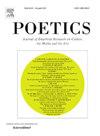Case for ecumenical use of network and geometric data analyses in mapping of cultural spaces: Illustration of contemporary French-speaking Swiss theatrical productions
IF 2
2区 社会学
0 LITERATURE
引用次数: 0
Abstract
The cross-use of network and geometric data analyses helps understand how the circulation of symbolic goods is structured. It follows specific logic, intersecting economic and symbolic planes in shaping spaces that do not entirely align with political borders. Both help map circulation spaces and understand their operational logic, aiming to visualize the proximities and/or distances between different places/actors in the production of these symbolic goods. Accordingly, based on several datasets collected to analyze the dynamics that structure contemporary French-speaking Swiss theater production circulation, this article aims to constitute a practical case on the combined use of Social Network Analysis (SNA) and Geometric Data Analysis (GDA) in mapping cultural spaces in a cross-fertilization perspective. The implementation of a mixed SNA and GDA analytical approach reveals distinct clusters of venues based on linguistic boundaries, size, cultural legitimacy, and audience reach. It identifies an "intermediate" subspace, between avant-garde and commercial productions. The study highlights methodological advantages in integrating SNA and GDA for developing a nuanced view on cultural dynamics, especially in understanding the career landscape of "ordinary" artists who navigate between artistic autonomy and market demands.
文化空间制图中网络和几何数据分析的普遍使用案例:当代法语瑞士戏剧作品的例证
网络和几何数据分析的交叉使用有助于理解符号商品的流通是如何结构的。它遵循特定的逻辑,在塑造不完全与政治边界对齐的空间时交叉经济和象征层面。两者都有助于绘制流通空间并理解其操作逻辑,旨在可视化这些象征性商品生产中不同地点/参与者之间的距离。因此,基于收集的几个数据集来分析当代法语瑞士戏剧生产流通的动态结构,本文旨在从交叉视角构建一个结合使用社会网络分析(SNA)和几何数据分析(GDA)来绘制文化空间的实际案例。SNA和GDA混合分析方法的实施揭示了基于语言边界、规模、文化合法性和受众范围的不同场所集群。它确定了前卫和商业作品之间的“中间”子空间。该研究强调了整合SNA和GDA的方法论优势,以形成对文化动态的细致看法,特别是在理解游走于艺术自主和市场需求之间的“普通”艺术家的职业前景方面。
本文章由计算机程序翻译,如有差异,请以英文原文为准。
求助全文
约1分钟内获得全文
求助全文
来源期刊

Poetics
Multiple-
CiteScore
4.00
自引率
16.00%
发文量
77
期刊介绍:
Poetics is an interdisciplinary journal of theoretical and empirical research on culture, the media and the arts. Particularly welcome are papers that make an original contribution to the major disciplines - sociology, psychology, media and communication studies, and economics - within which promising lines of research on culture, media and the arts have been developed.
 求助内容:
求助内容: 应助结果提醒方式:
应助结果提醒方式:


